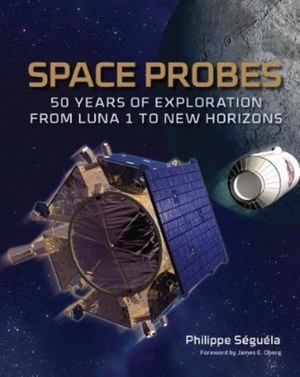Review: Space Probesby Jeff Foust
|
| Space Probes is a book that is comprehensive but not necessarily thorough in its review of the history of planetary exploration. |
The peaks and valleys of planetary exploration over the last five decades are chronicled in Space Probes. Author Philippe Séguéla provides details about every major space probe—defined here as a robotic spacecraft that travels beyond Earth to explore other bodies in our solar system—flown by the US, USSR/Russia, Europe, and others since 1959, when the Soviets flew the first successful lunar flyby, Luna 1. Séguéla organizes the book by destination, hopscotching across the solar system: the Moon, Venus, and Mars are followed by the outer solar system, before returning to Mercury and Sun before wrapping up with comets and asteroids. He then examines the missions to each destination chronologically, with the lesser missions getting a single page and more prominent ones getting as many as a dozen.
The result is a book that is comprehensive but not necessarily thorough. Even the major missions that get longer treatments in the book don’t go into great detail about them or provide lesser-known, insiders’ accounts of their development and operation that may appeal to readers. (That may be due to the fact that Séguéla is more of a devoted space enthusiast than a professional involved in planetary science or spaceflight: his primary occupation is as a professor of neuroscience at McGill University in Montreal.) The book, which has the appearance and heft of a textbook, is filled with hundreds of images, many in color, of and from these missions. However, if you’re already familiar with these missions, or know where to find more information about them from online and other resources, Space Probes doesn’t add a lot beyond packaging the history of planetary exploration into a single volume, something that may not be worth the relatively high price.
While we appear today to be in a second golden age of planetary exploration, there are growing doubts that this era can be sustained through the current decade. The ever-increasing costs of sophisticated spacecraft, coupled with constrained budgets, particularly with NASA’s science program, raise questions about whether some of the missions on scientists’ wish lists—a Mars sample return mission and a Europa orbiter, among others—are feasible in the foreseeable future. Séguéla doesn’t address this directly in the book, but argues that one of the one of the factors that has become a major impetus for planetary exploration, the search for evidence of past or present life beyond Earth, could “shift future space exploration in directions impossible to appreciate today” if successful. Perhaps, then, the true golden age of planetary exploration is the one yet to come.
